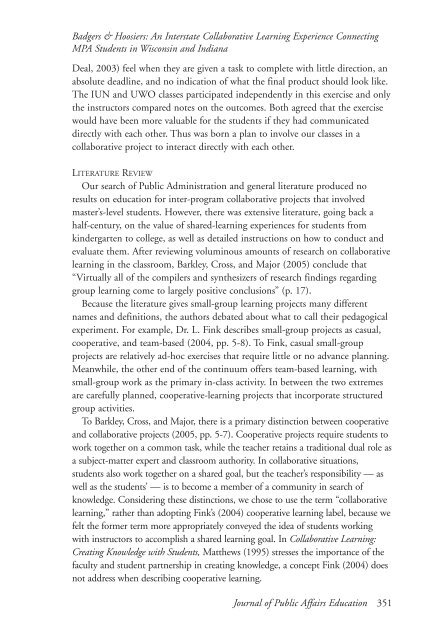journal of public affairs education - NASPAA *The Global Standard ...
journal of public affairs education - NASPAA *The Global Standard ...
journal of public affairs education - NASPAA *The Global Standard ...
- No tags were found...
Create successful ePaper yourself
Turn your PDF publications into a flip-book with our unique Google optimized e-Paper software.
Badgers & Hoosiers: An Interstate Collaborative Learning Experience ConnectingMPA Students in Wisconsin and IndianaDeal, 2003) feel when they are given a task to complete with little direction, anabsolute deadline, and no indication <strong>of</strong> what the final product should look like.The IUN and UWO classes participated independently in this exercise and onlythe instructors compared notes on the outcomes. Both agreed that the exercisewould have been more valuable for the students if they had communicateddirectly with each other. Thus was born a plan to involve our classes in acollaborative project to interact directly with each other.LITERATURE REVIEWOur search <strong>of</strong> Public Administration and general literature produced noresults on <strong>education</strong> for inter-program collaborative projects that involvedmaster’s-level students. However, there was extensive literature, going back ahalf-century, on the value <strong>of</strong> shared-learning experiences for students fromkindergarten to college, as well as detailed instructions on how to conduct andevaluate them. After reviewing voluminous amounts <strong>of</strong> research on collaborativelearning in the classroom, Barkley, Cross, and Major (2005) conclude that“Virtually all <strong>of</strong> the compilers and synthesizers <strong>of</strong> research findings regardinggroup learning come to largely positive conclusions” (p. 17).Because the literature gives small-group learning projects many differentnames and definitions, the authors debated about what to call their pedagogicalexperiment. For example, Dr. L. Fink describes small-group projects as casual,cooperative, and team-based (2004, pp. 5-8). To Fink, casual small-groupprojects are relatively ad-hoc exercises that require little or no advance planning.Meanwhile, the other end <strong>of</strong> the continuum <strong>of</strong>fers team-based learning, withsmall-group work as the primary in-class activity. In between the two extremesare carefully planned, cooperative-learning projects that incorporate structuredgroup activities.To Barkley, Cross, and Major, there is a primary distinction between cooperativeand collaborative projects (2005, pp. 5-7). Cooperative projects require students towork together on a common task, while the teacher retains a traditional dual role asa subject-matter expert and classroom authority. In collaborative situations,students also work together on a shared goal, but the teacher’s responsibility — aswell as the students’ — is to become a member <strong>of</strong> a community in search <strong>of</strong>knowledge. Considering these distinctions, we chose to use the term “collaborativelearning,” rather than adopting Fink’s (2004) cooperative learning label, because wefelt the former term more appropriately conveyed the idea <strong>of</strong> students workingwith instructors to accomplish a shared learning goal. In Collaborative Learning:Creating Knowledge with Students, Matthews (1995) stresses the importance <strong>of</strong> thefaculty and student partnership in creating knowledge, a concept Fink (2004) doesnot address when describing cooperative learning.Journal <strong>of</strong> Public Affairs Education 351
















